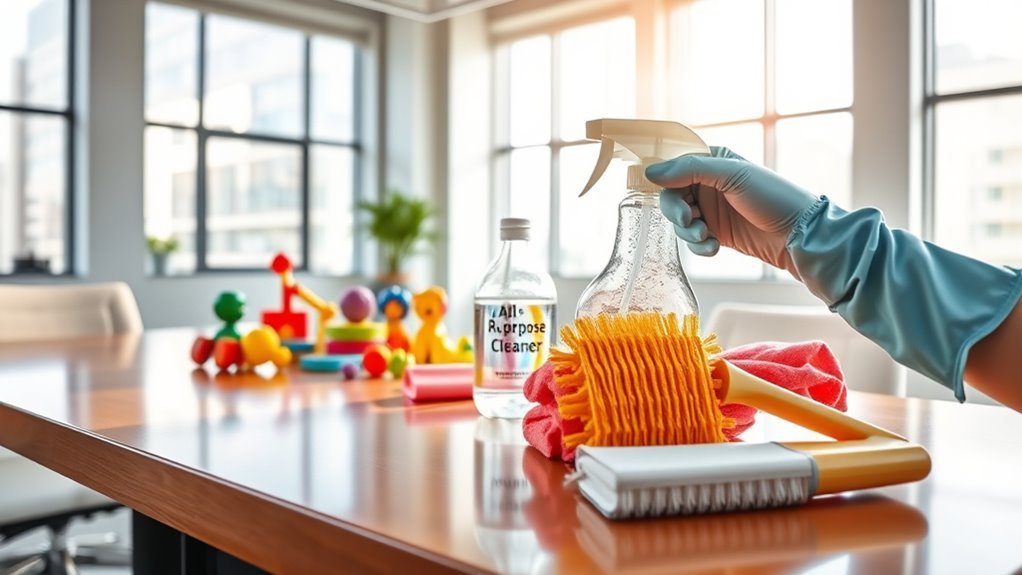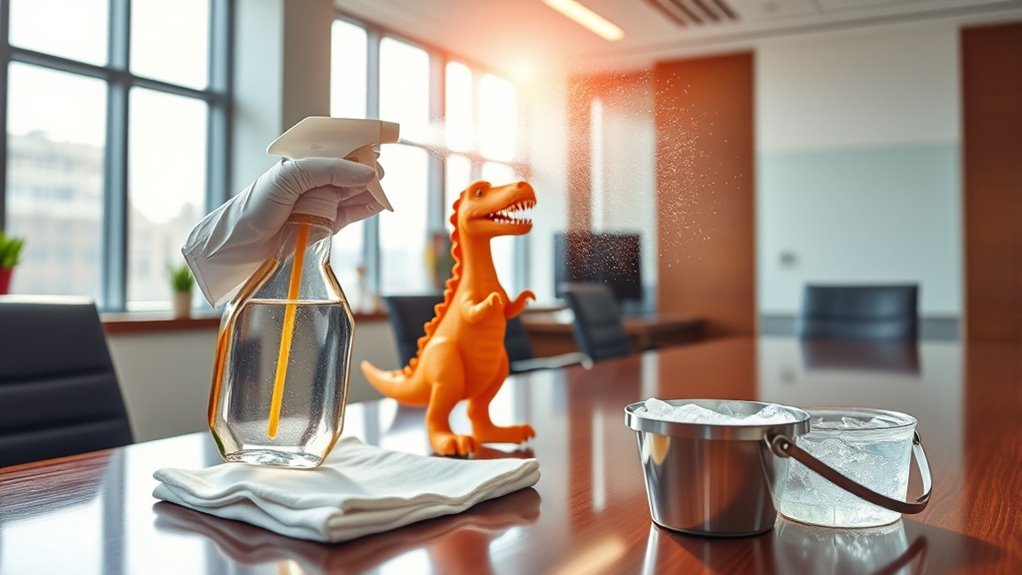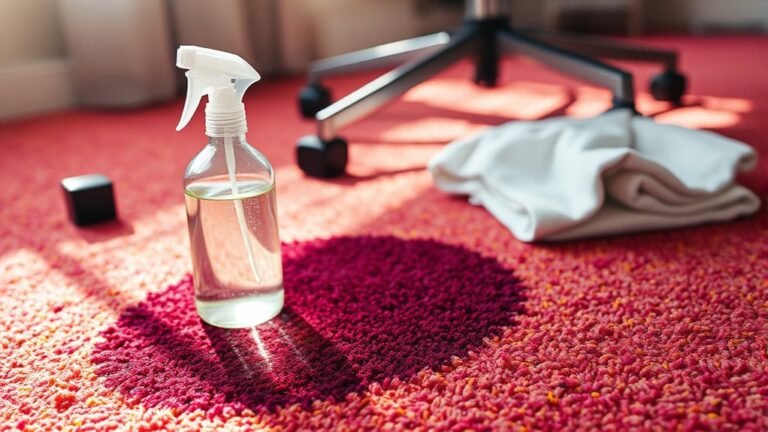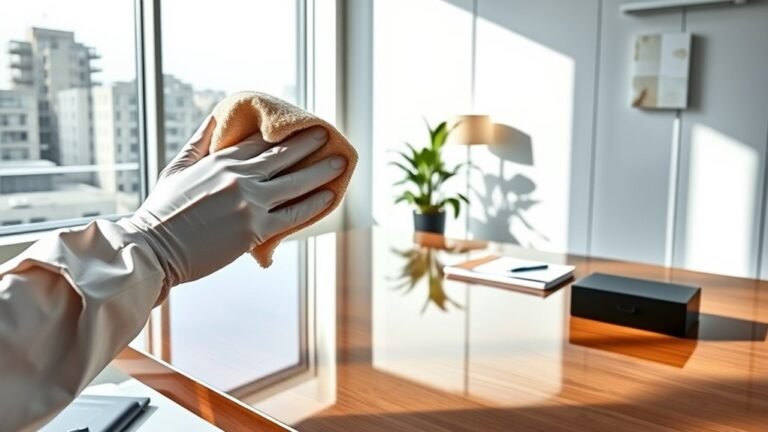How to Clean Toys in Office Spaces
To keep your office toys like stress balls, fidget spinners, and board game pieces clean, wipe them regularly with mild soap or disinfectant wipes and let them air dry. Soft toys may need gentle hand washing, while hard plastic items can be scrubbed with a mild detergent solution. Always avoid harsh chemicals to prevent damage. Store toys properly and encourage handwashing to reduce germs. If you want to maintain a healthy, inviting workspace, there’s more useful advice to help you stay on top of it.
Identifying Common Office Toys That Need Cleaning

When you think about toys in office spaces, items like stress balls, fidget spinners, and desk puzzles probably come to mind. These toy types are popular because they help you stay relaxed and focused throughout the workday. But remember, each of these toys needs regular cleaning to keep your workspace fresh and hygienic. You might also have small figurines, magnetic building blocks, or even mini basketball hoops on your desk. Knowing the cleaning frequency depends on how often you use them—daily use demands weekly cleaning, while occasional toys can be cleaned monthly. By identifying which toys you have and how frequently you handle them, you can create a simple cleaning routine that fits your lifestyle, giving you the freedom to enjoy your office toys without worry.
Understanding the Risks of Dirty Office Toys
Anyone who uses toys in the office should be aware that dirty toys can harbor germs and bacteria, posing health risks. When you share or frequently handle office toys without cleaning them, toy contamination becomes a real issue. These germs can spread quickly, leading to common health concerns like colds, flu, or skin infections. Since office environments often involve close contact, a contaminated toy isn’t just a personal risk—it can affect your whole team. Recognizing these risks helps you take control of your workspace’s cleanliness and protect your well-being. Don’t let overlooked toy contamination limit your freedom to enjoy stress-relief toys safely. Staying informed about these health concerns empowers you to keep your environment cleaner and healthier for everyone.
Recommended Cleaning Materials and Supplies

To keep office toys clean, you’ll need the right materials and supplies. Choosing essential cleaning agents, effective tools, and safe disinfectants makes the process easier and safer. Let’s look at what works best for maintaining hygiene without damaging the toys.
Essential Cleaning Agents
Although cleaning toys in office spaces might seem straightforward, choosing the right cleaning agents is essential to confirm they’re both safe and effective. You’ll want to lean towards natural disinfectants that kill germs without harsh chemicals, keeping the environment healthy and free from toxins. Eco friendly cleaners are a smart choice—they protect your space and the planet, letting you maintain freedom from harmful residues. Look for products with simple, recognizable ingredients like vinegar, baking soda, or plant-based extracts. These options clean thoroughly without compromising safety. Avoid bleach or anything abrasive that might damage the toys or irritate skin. By selecting gentle yet powerful agents, you confirm toys stay clean, safe, and ready for use, all while supporting a sustainable and healthy office atmosphere.
Suitable Cleaning Tools
When selecting cleaning tools for toys in office spaces, you’ll want materials that are both effective and gentle. Opt for soft microfiber cloths to wipe down surfaces without scratching, and keep a small, soft-bristled brush handy for crevices. Disposable wipes designed for electronics can also work well, avoiding excess moisture. Avoid abrasive sponges or harsh scrubbing tools that could damage toys or office supplies nearby. A spray bottle with water or a mild cleaning solution lets you control moisture application, preventing damage to sensitive items. By choosing the right cleaning tools, you’ll maintain a clean, safe environment that respects both your toys and the freedom to work and relax comfortably. Remember, smart cleaning tools make the process quick, thorough, and hassle-free.
Safe Disinfectant Options
Choosing the right cleaning tools is just part of the process; selecting safe disinfectant options is equally important to keep toys in office spaces hygienic without causing damage. You want solutions that’re effective yet gentle, allowing you freedom from harsh chemicals. Eco friendly options help protect both your workspace and the planet while still tackling germs efficiently. Homemade solutions offer a natural, budget-friendly alternative you can trust.
Consider these safe disinfectant choices:
- Diluted white vinegar, for a natural antibacterial boost
- Mild dish soap mixed with warm water, a gentle everyday cleaner
- Alcohol-based wipes (70% isopropyl), quick and effective for plastic surfaces
- Essential oils like tea tree or lavender, combined with water for a fresh, antimicrobial spray
Using these keeps toys clean, safe, and free from harmful residues.
Step-by-Step Cleaning Process for Soft Toys

Since soft toys can easily trap dust, dirt, and germs, you’ll want to clean them regularly to keep your office space healthy. First, identify the soft toy types you have—stuffed animals, fabric dolls, or plush cushions—as each may need different care. Check the labels for washing instructions and decide on the cleaning frequency based on how often they’re used. For lightly soiled toys, a gentle hand wash with mild detergent works well. For more durable types, you can use a washing machine on a delicate cycle inside a mesh bag. Always air dry to prevent damage. Spot clean any stubborn stains promptly. By following these steps, you’ll maintain a fresh, inviting office environment while enjoying the freedom to keep your soft toys clean and safe.
Cleaning Procedures for Hard Plastic and Rubber Toys
When cleaning hard plastic and rubber toys, you’ll want to choose cleaning agents that are effective yet safe for the materials. Start by wiping them down with a mild detergent solution, then rinse thoroughly to remove any residue. Finally, make sure the toys are completely dry before storing them to prevent mold and damage.
Suitable Cleaning Agents
Although hard plastic and rubber toys differ in texture, you’ll find that many cleaning agents work well for both materials. Choosing the right cleaner lets you keep toys fresh without harsh chemicals, preserving the freedom to use them safely in shared office spaces. Eco friendly cleaners offer a gentle yet effective option, while antibacterial wipes provide quick, convenient sanitation.
Consider these suitable cleaning agents:
- Mild dish soap mixed with warm water for a thorough cleanse
- Eco friendly cleaners that avoid toxic residues
- Antibacterial wipes for fast, on-the-go cleaning
- Diluted white vinegar solution as a natural disinfectant
Cleaning Steps Overview
Before you start cleaning, it’s important to follow a clear set of steps to guarantee both hard plastic and rubber toys are sanitized effectively without damage. First, gather your toys and sort them based on material, respecting office guidelines for hygiene. Rinse each toy under warm water to remove surface dirt. Next, apply your chosen cleaning agent, scrubbing gently with a soft brush or cloth, focusing on crevices. Be cautious with rubber toys to avoid harsh chemicals that can degrade them. After cleaning, rinse thoroughly to eliminate residue. This routine supports toy organization by keeping items clean and ready for use. By sticking to these steps, you maintain a healthy office environment while enjoying the freedom to share and use toys responsibly.
Drying and Storage Tips
Anyone handling toy cleaning knows that proper drying and storage are just as essential as washing. Choosing the right drying methods guarantees your hard plastic and rubber toys stay in top shape without moisture damage or mildew. You want quick, efficient drying that keeps toys fresh and ready for use.
For effective drying and storage, keep these tips in mind:
- Air-dry toys on a clean, breathable surface to prevent water spots
- Use microfiber cloths for gentle, streak-free drying
- Store toys in ventilated containers to avoid trapping humidity
- Arrange toys loosely to maintain airflow and easy access
Disinfecting Shared Board Games and Puzzle Pieces
When you’re disinfecting shared board games and puzzle pieces, it’s important to use methods that won’t damage the materials. To keep things safe without sacrificing quality, opt for gentle disinfectants like alcohol wipes or a diluted bleach solution. Avoid soaking cardboard or paper game boards to prevent warping. Focus on game piece sanitization by wiping each piece thoroughly, especially those handled frequently. Encourage player hygiene precautions by asking everyone to wash their hands before and after playing. This simple routine helps reduce germs and keeps your shared games enjoyable for all. By balancing effective cleaning with care, you maintain both the integrity of your games and the freedom to play confidently in your office space.
Tips for Regular Maintenance and Hygiene
Keeping shared games clean is just one part of maintaining a healthy office environment. You want to enjoy your break without worrying about germs, so focusing on regular toy hygiene is key to office cleanliness. Here’s how you can keep things fresh and inviting:
- Wipe down toys with disinfectant wipes after each use to minimize bacteria buildup.
- Schedule weekly deep cleans using mild soap and water for plastic and silicone toys.
- Store toys in a designated, clean container to avoid dust and contamination.
- Encourage everyone to wash hands before and after playing to reduce germ transfer.
Encouraging Office-wide Cleanliness Practices
Although maintaining clean toys is important, fostering office-wide cleanliness habits guarantees a healthier environment for everyone. You can lead by example, showing how simple actions like wiping down shared items and washing hands contribute to better office health. Encouraging open conversations about cleanliness culture helps everyone feel responsible without feeling restricted. Offering easy access to cleaning supplies empowers your team to act freely and promptly. You might also introduce light reminders or fun challenges promoting tidiness, making the process more engaging. When everyone embraces these habits voluntarily, it creates a natural rhythm of care and respect for shared spaces. This approach assures that maintaining toy hygiene is part of a broader commitment, enhancing overall wellness and freedom in your workspace.
Frequently Asked Questions
How Often Should Office Toys Be Replaced Instead of Cleaned?
Think of office toys like the trusty sails on your freedom ship—they weather wear and tear over time. You’ll want to keep an eye on their toy lifespan; when they start to fray or lose their charm, it’s time to follow a clear replacement schedule. Usually, swapping them out every 6-12 months keeps the vibe fresh and fun. Don’t let worn-out toys anchor your creativity—replace them to keep your workspace lively and inspiring.
Are There Eco-Friendly Cleaning Products Safe for Office Toys?
You’ll find plenty of eco friendly options that keep toy safety front and center. Look for natural sprays or wipes made from plant-based ingredients—they’re gentle yet effective, so you won’t worry about harmful chemicals. Plus, these products often come in recyclable packaging, helping you reduce waste. Choosing these green cleaning solutions means you’re protecting both your office vibe and the planet, giving you the freedom to keep things fresh without compromise.
Can Cleaning Toys Reduce Allergens in the Office Environment?
Yes, regular cleaning can seriously boost allergen reduction in your office. When you keep toys clean, you’re not just maintaining their appearance—you’re also cutting down on dust, pollen, and other irritants that can build up over time. Toy maintenance plays a key role in creating a fresher, healthier environment, so you can enjoy your space without worrying about pesky allergens getting in the way of your freedom to work comfortably.
What Is the Best Storage Method to Keep Toys Clean?
Think of toy organization like a well-tuned orchestra—everything in its place creates harmony. To keep toys clean, you’ll want storage solutions that seal out dust and germs, like clear bins with lids or breathable fabric containers. This way, you maintain freedom from clutter while protecting toys from dirt. Easy-to-access storage also lets you grab what you need quickly, keeping your space tidy and your mind free to focus on what truly matters.
Should Employees Clean Their Own Toys or Is Centralized Cleaning Preferred?
You’ll find a balance between personal responsibility and team collaboration works best. Letting employees clean their own toys gives you freedom and control over hygiene, while a centralized cleaning system guarantees consistency and saves time. You might encourage everyone to take care of their items but also schedule group cleanings occasionally. This way, you keep things flexible yet efficient, fostering a cooperative environment without feeling restricted.






